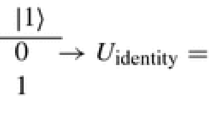Abstract
The idea of information encoding on quantum bearers and its quantum-mechanical processing has revolutionized our world and brought mankind on the verge of enigmatic era of quantum technologies. Inspired by this idea, in present paper, we search for advantages of quantum information processing in the field of machine learning. Exploiting only basic properties of the Hilbert space, superposition principle of quantum mechanics and quantum measurements, we construct a quantum analog for Rosenblatt’s perceptron, which is the simplest learning machine. We demonstrate that the quantum perceptron is superior to its classical counterpart in learning capabilities. In particular, we show that the quantum perceptron is able to learn an arbitrary (Boolean) logical function, perform the classification on previously unseen classes and even recognize the superpositions of learned classes—the task of high importance in applied medical engineering.

Similar content being viewed by others
References
Nielsen, M.A., Chuang, I.L.: Quantum Computation and Quantum Information. Cambridge University Press, Cambridge (2000)
Georgescu, I.M., Ashhab S., Nori, F.: Quantum simulation. Rev. Mod. Phys. (2014, in press)
Gisin, N., Ribordy, G., Tittel, W., Zbinden, H.: Quantum cryptography. Rev. Mod. Phys. 74, 145–195 (2002)
Vedral, V.: The role of relative entropy in quantum information theory. Rev. Mod. Phys. 74, 197–234 (2002)
Childs, A.M., van Dam, W.: Quantum algorithms for algebraic problems. Rev. Mod. Phys. 82, 1–52 (2010)
Kecman, V.: Learning and soft computing: support vector machines, neural networks, and fuzzy logic models. MIT Press, Cambridge (2001)
Russell, S.J., Norvig, P.: Artificial Intelligence: A Modern Approach. Prentice Hall, New Jersey (2009)
Menneer, T., Narayanan, A.: Quantum-Inspired Neural Networks, Tech. Rep. R329, Univ. of Exeter (1995)
Andrecut, M., Ali, M.K.: A quantum perceptron. Int. J. Mod. Phys. B 16, 639–645 (2002)
Kouda, N., Matsui, N., Nishimura, H., Peper, F.: Qubit neural network and its learning efficiency. Neural Comput. Appl. 14, 114–121 (2005)
Zhou, R., Qin, L., Jiang, N.: Quantum perceptron network. LNCS 4131, 651–657 (2006)
Zhou, R., Ding, Q.: Quantum M–P neural network. Int. J. Theor. Phys. 46, 3209–3215 (2007)
Manzano, D., Pawlowski, M., Brukner, C.: The speed of quantum and classical learning for performing the kth root of NOT. New. J. Phys. 11, 113018 (2009)
Ladd, T.D., Jelezko, F., Laflamme, R., Nakamura, Y., Monroe, C., OBrien, J.L.: Quantum computers. Nature 464, 45–53 (2010)
Rosenblatt, F.: The Perceptron—A Perceiving and Recognizing Automaton, Rep. 85–460-1, Cornell Aeronautical Laboratory, New York (1957)
Minsky, M., Papert, S.: Perceptrons: An Introduction to Computational Geometry. MIT Press, Cambridge (1969)
Parker, P., Englehart, K., Hugdins, B.: Control of Upper Limb Prosthesis, 1st edn. Wiley-IEEE Press, New York (2004)
Jiang, N., Dosen, S., Müller, K.-R., Farina, D.: Myoelectric control of artificial limbs is there a need to change focus? IEEE Signal Process. Mag. 29, 147–150 (2012)
Siomau, M., Jiang, N.: Myoelectric Control of Artificial Limb by, Quantum Information Processing, arXiv:1302.3934
Acknowledgments
I thank Ning Jiang and Dario Farina for discussions. A part of this work has been done during my visit to the Department of Neurorehabilitation Engineering, Georg-August University Medical Center Göttingen.
Author information
Authors and Affiliations
Corresponding author
Additional information
This work is supported by KACST under research Grant No. 34-37.
Rights and permissions
About this article
Cite this article
Siomau, M. A quantum model for autonomous learning automata. Quantum Inf Process 13, 1211–1221 (2014). https://doi.org/10.1007/s11128-013-0723-5
Received:
Accepted:
Published:
Issue Date:
DOI: https://doi.org/10.1007/s11128-013-0723-5




